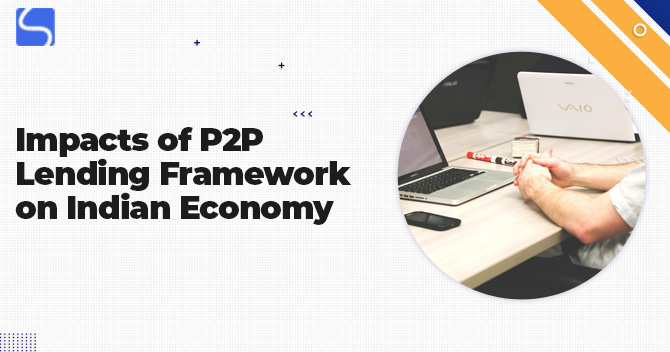Impacts of P2P Lending Framework on Indian Economy

Karan Singh | Updated: Jun 05, 2021 | Category: Peer to Peer lending
The Peer-to-Peer is a digital platform that focuses on filling the gap between individuals who can lend & those who are looking for credit without collateral. The foremost transition of this business occurs about two years back in the form of RBI (Reserve Bank of India) regulations which allow high-end investors to lend money to borrowers with a compromised financial background.
Presently, most of the Peer-to-Peer platforms provide credit without any guarantee to the salaried and business individual for growth, marriage, medical expenses, etc. One way Indian fintech continues to develop as a foremost player in the finance world is to enable fintech-based lending. P2P Lending is representing a sign of future potential in the nation. There is no denying that such P2P lending transactions are one of the noteworthy developments of the decade.
Table of Contents
Regulations to Renovate the Financial Background
With the nation representing a broad mobile user base of around 1.2 billion in the year of 2019 along with an aim on financial inclusion, Peer to Peer Lending has brought a significant disturbance in the way individuals avail loans and the function of the bank in this. With the RBI or the Reserve Bank of India coming out with master directions concerning peer in the year of 2017, the industry has a specific set of regulations & guidelines. The Government took certain measures to renovate the financial background that administrate this industry. In 1982, the RBI Governor executed a regulatory structure that officially connects the banking sector, NBFCs, and unorganised sector to evaluate the nation’s financial system from an extensive point of view.
Widen the Horizons for Guiding the Economy – P2P Lending Framework
Accounting for the well-built part of the population, this segment has been guiding the economy significantly. Past economic crisis and current Non-Banking Financial Companies issues have forced the Government & authority to look for another feasible alternative. P2P lending platform exhibited huge potential, primarily due to confined interest rate, user-friendly application, and speedy lending decisions.
Further, the Government eases out the thing for P2P lending by reporting 5X lending-cap extension, which was earlier limited at Rs. 10 lakh. Considering the rising competition in this area, such an extension will aid such platforms attracting venture capitalists’ attention. The decision of the Government to expand the credit portfolio would let such a platform grow at a much rapid pace.
The Reserve Bank of India has recommended all Peer-to-Peer operators hire a trustee to examine the transactions pattern between the escrow account of borrowers and lenders. The guidelines of the Reserve Bank of India simplify that the P2P must obtain at least two escrow account; one for funds is coming from the lender and another one for the collections from borrowers. The account should be monitored by the trustee, and such an individual should be promoted by the bank.
Flourishing at a Faster Pace – P2P Lending Framework on Indian Economy
In India, the Peer-to-Peer business till now based on the development of retail & MSME lending, which is unobserved by the Non-Banking Financial Companies and financial institutions. The sector was a capable one and a money producer for confidentially held lenders, who are primarily informal lenders. On lending, it can alternative this informal lending by the Reserve Bank of India particular entity. On the investment front, Peer-to-Peer will cement its place in a financial market as an existing investment option, challenging against the market-linked alternatives like Mutual Funds[1] and Stocks.
What are the Significant Factors of P2P Lenders?
Here why P2P Lending will be the next huge thing in the financial market that emerges with such significant factors of P2P Lenders; those are as follows:

- Rates of Interest: Investor to Collect a Good Interest Rate
Interest rate is probably the essential factor for peer-to-peer lenders. The Peer to Peer platform can permit the investor to collect a good interest rate annually. Since a traditional saving account does not offer the finest interest rate, many individuals left with no alternate options than determining a possible alternative to gather more benefits of their funds, consisting of Peer-to-Peer investing.
- Diversification in Profitable Opportunities
Most of the P2P lending hub provides a product that can expand your invested money across various profitable opportunities. This diversification is cost-effective because it decreases your risk since you are confining your funds into a single loan.
- Effortlessness of Use with User-friendly Platforms
Peer to Peer platforms are user-friendly when diverse with other investment options like stocks and shares. Peer to Peer investment implements on online platforms with minimum terminology. Anyone can get commenc4ed with Peer to Peer platform consisting of those who have not much of an experience in finance. Also, Peer to Peer platforms also has a diverse portfolio of the investment strategy that even attracts the lower-income group.
- Resultant Market to Sell Parts of the Credit
While investing, you should not make an assumption concerning exiting the investment at the first stage. However, the secondary market provides an opportunity to sell parts of the credit to other investors on the P2P platform. A secondary market provides liquidity to an individual dealing in investment if they require getting money in advancement than planned.
- Variety to Provide Different Purposes
Peer to Peer lenders’ norms is less strict than traditional banks in India. The borrowers who raise the money from such lending platforms can use it to serve various purposes. This shows that as an investor, you have simple choices for lending their capital. Such loans are generally used for funding small scale enterprises, housing developments, or helping borrowers to widen their portfolio of property.
Conclusion
Shortage of funds and limited resources are the huge aspect that decides the outcome of P2P lending in India. Since traditional banks controlled borrowers from getting a loan without a guarantee, such lending platforms could prove to be a game-changer in this factor. If you want some additional view on this topic, you can freely contact t to any legal professional.
Read our article:5 Important Things You Must Know Before Borrowing Money From P2P Lenders













